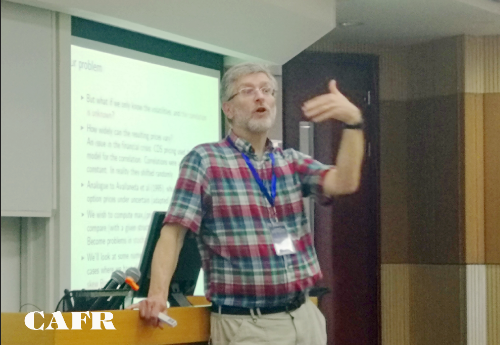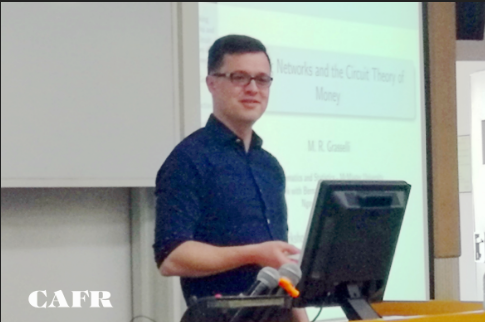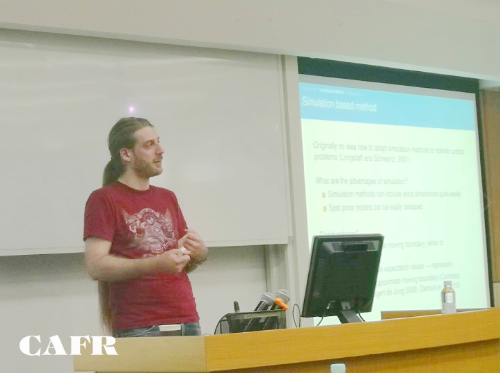May 14, 2018. Shanghai - How can one bridge the gap between academia and industry? And how will mathematics help with the overall improvement of society by solving economic, financial and even energy problems? As a response to these questions, five Canadian scholars in mathematics gathered at the CAFR Workshop on Mathematical Finance and presented their most recent research projects. They were:
- Prof. Tom Salisbury, York University;
- Prof. Matheus Grasselli, McMaster University;
- Nathan Gold, PHD Candidate, York University;
- Andrew Day, PHD Candidate, University of Western Ontario;
- Prof. Sebastian Jaimungal, University of Toronto.
The workshop was initiated and moderated by Prof. Samuel Drapeau from China Academy of Finance Research, Shanghai Jiao Tong University.
After a short welcome speech delivered by Prof. Drapeau, Prof. Tom Salisbury shared his co-authored paper: “Uncertain Correlation and Credit Derivatives”. In the paper, he and his coauthors consider a credit derivative involving two stocks whose marginal laws are known, but whose correlation is uncertain. And they attempt to answer the question: how large a spread can there be in price, and what are the best-case or worst-case scenarios? Prof. Salisbury illustrated this numerically in some generality, and discussed particular payoffs for which they could find closed form solutions. The most interesting of these involves rapid switching of correlations and leads to a new characterization of skew Brownian motion.

Prof. Tom Salisbury, York University
Prof. Grasselli began his presentation of the paper “Banking Networks and the Circuit Theory of Money” with the question “10 years on, what have we learned?” In the paper, he and his authors consider a network of banks with interconnected balance sheets coupled with a macroeconomic model for households, firms, and the government sector. The key feature of the model is that money is created endogenously by the banking sector to satisfy the demand for loans and deposits of the other economic agents. The macroeconomic core model is driven by stochastic consumption, with firms adjusting investment according to realized profits and capacity utilization. Stock-flow consistent between savings of the different sectors in turn give the total amount of external loans and deposits for the banking sector. They then assume that these aggregate quantities are distributed among the banks using a preferential attachment mechanism and study the stability of the resulting network. Crucially, the amplification of shocks within the banking network can, by rationing of available credit, drive the macroeconomic model away from its stable equilibrium and provoke an economic crisis.

Prof. Matheus Grasselli, McMaster University
While presenting his paper “Change-Point Detection and Forecasting of the U.S. Dollar Index and Equity Markets”, Nathan Gold pointed out that while the commonality of liquidity between foreign exchange and equity markets had recently been studied, less attention had been paid to common structural breaks in both markets. Common structural breaks are suggestive of a dominant common risk factor between these different markets, similar to risk factors found between equity markets. Such structural breaks violate the assumption of stationary return distributions, leaving fixed parametric models unable to generalize over different temporal regions, and voiding forecasts. To study these effects and detect changes in real time, they apply a Bayesian online change-point detection algorithm to determine economic regime changes in the returns of the U.S. Dollar Index and the S\&P 500 from 2005-2015. Using a nonlinear Gaussian process time series model to forecast future observations and detect regime changes, they are able to link worldwide economic and political events to regime changes in both the U.S. Dollar Index and the S\&P 500, and find commonality in periods of high volatility between these markets.

Nathan Gold, PHD Candidate, York University
Andrew Day’s study “Connection between Flux/Slope Limiter Methods and Simulation Based Approaches for Optimal Control of Energy Storage” focuses on the problem of energy storage, which is a key problem facing society as the human race makes the transition to the new “green” energy economy. Determining optimal control strategies for storage facilities in the face of market-determined prices for electricity requires the numerical solution of partial differential equations (PDEs). In this talk, Day highlighted the various difficulties arising from numerically solving this PDE along with an alternative approach based on the least squares Monte Carlo method.

Andrew Day, PHD Candidate, University of Western Ontario
According to his presentation, Prof. Sebastian Jaimungal’s paper “Algorithmic Trading with Partial Information: A Mean Field Game Approach” addresses an algorithmic trading problem with collections of heterogeneous agents who aim to perform statistical arbitrage, where all agents filter the latent states of the world, and their trading actions have permanent and temporary price impact. This leads to a large stochastic game with heterogeneous agents. He and his coauthor solve the stochastic game by investigating its mean-field game (MFG) limit, with sub-populations of heterogeneous agents, and, using a convex analysis approach, they show that the solution is characterized by a vector-valued forward-backward stochastic differential equation (FBSDE). They demonstrate that the FBSDE admits a unique solution, obtain it in closed-form, and characterize the optimal behavior of the agents in the MFG equilibrium. Moreover, they prove the MFG equilibrium provides an ϵ-Nash equilibrium for the finite player game. They conclude by illustrating the behavior of agents using the optimal MFG strategy through simulated examples.

Prof. Sebastian Jaimungal, University of Toronto
Throughout the workshop, the audience showed their great interest in the papers. They posed questions and gave suggestions, which provided new insights for the presenters to make further improvement on their studies.
About CAFR
China Academy of Financial Research (CAFR) is a research institute affiliated to Shanghai Jiao Tong University. We are devoted to establish a top-notch open financial research platform and think tank to support the financial reform and financial market development in China. CAFR introduces cutting-edge finance theories, methodologies and technologies to studying practical issues in China’s financial system reform and financial market development, and our research team is composed of leading scholars in finance from domestic and abroad. We provide policy advices to government decision makers as well as solutions to financial institutions and corporations.
CAFR collaborates with China’s government agencies closely and has been appointed as the academic research partner for the People’s Bank of China, Shanghai Head Office. We have established extensive research network with institutions in academia and financial industry as well.
We also host high-end event series for scholars, government officials and industry elites to exchange ideas. Shanghai Finance Forum, one of our event series, has been recognized as an impactful communication platform to discuss the issues in developing Shanghai into an international financial center.






